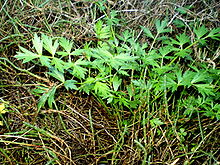Apium prostratum
| Sea celery | |
|---|---|
 |
|
| Scientific classification | |
| Kingdom: | Plantae |
| (unranked): | Angiosperms |
| (unranked): | Eudicots |
| (unranked): | Asterids |
| Order: | Apiales |
| Family: | Apiaceae |
| Genus: | Apium |
| Species: | A. prostratum |
| Binomial name | |
|
Apium prostratum Labill. ex Vent. |
|
Apium prostratum, commonly known as sea celery, is a variable herb native to coastal Australia and New Zealand. The leaves are variable, with toothed leaflets, and a celery like aroma. The tiny white flowers occur in clusters.
There are two varieties:
The subspecies Apium prostratum subsp. howense is endemic to Lord Howe Island.
Sea celery was an important vegetable for early Australian explorers and colonists. Captain Cook ate sea celery at Botany Bay and gathered it in bulk along with Lepidium oleraceum at Poverty Bay in New Zealand in October 1769 to protect his crew from scurvy. It was commonly eaten by colonists as a survival food in the early days of the Sydney colony.
Both leaf and stem are eaten. Dried leaves are used in native Australian spice mixes. It tastes much the same as celery and is used to flavour soups. Variety filiforme is considered to be more palatable.
It was first cultivated by colonists around Albany, Western Australia, as a vegetable. It is commercially cultivated to a limited extent.
...
Wikipedia
